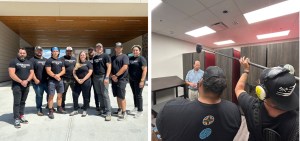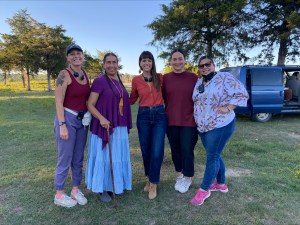Oklahoma might not be the first place that comes to mind when you think of a thriving film industry. But there’s something big cooking in the state, and the Cherokee Nation is at the helm.
Over the past year, I’ve been captivated by the work of Cherokee Film, a media company ushering in a new era of authentic Indigenous storytelling. So I hopped on a plane to the Sooner State to see it for myself.
Stepping off the plane, I met Jennifer Loren, senior director of Cherokee Film in Tulsa. Her energy and passion for opening doors for Native talent were palpable as she gave me a thorough tour of everything. From cutting-edge production facilities to innovative training programs, Loren unveiled the inner workings of Cherokee Film’s four groundbreaking pillars. With each stop, I grew more excited about the future of Indigenous cinema and the careers Cherokee Film is helping launch. This is a story that needs to be told.
Cherokee Film encompasses four major components working in synergy to uplift Indigenous cinema: The Cherokee Film Commission promotes and facilitates production in the region, while Cherokee Film Productions directly develops and produces award-winning film and TV content for audiences across the globe. The Cherokee Film Institute focuses on education, providing training programs to cultivate the next generation of multi-skilled Native media makers. Cherokee Film Studios offers a homegrown, infrastructure for filming, editing and other post-production needs.
Collectively, the initiative’s pillars strive to vertically integrate and support Indigenous creators by providing resources across the production spectrum. From Native American talent and crew directories, the ultimate goal is to ensure sustainable careers for Native storytellers. With this supportive infrastructure that offers both training and hands-on mentorship, the Cherokee Nation is poised to nurture the next generation of Indigenous cinema.
The creation of this ecosystem stems from the lack of representation for Indigenous people across the board. “We’re represented at less than 1 percent,” Loren said. “We had to do something about it.”
Director Erica Tremblay, Casey Camp-Horinek, Jennifer Loren, Lily Gladstone and Keysa Parker on the set of indie drama Fancy Dance.
The comprehensive system has already begun to bear fruit, as evidenced by the successful filming of Erica Tremblay and Miciana Alise’s Fancy Dance which stars Golden Globe Winner Lily Gladstone, and the casting contributions to Martin Scorsese’s Killers of the Flower Moon, showcasing the impactful and growing presence of Cherokee Film in the industry.
RELATED: ‘Killers Of The Flower Moon’ Star Lily Gladstone Warns Indigenous Viewers Of Film’s Traumatic Impact
Loren feels the lack of visibility and inclusion can make marginalized groups feel “excluded” from society. This issue manifests both locally, within communities like the Cherokee Nation, and nationally, where Indigenous people often remain invisible unless veiled in stereotypical depictions that further marginalize Indigenous peoples.
“More authentic portrayals are needed at all levels to truly reflect the diversity of voices and experiences,” Loren said. “Representation matters because it signals who is valued in a community. When people don’t see themselves reflected in the media, the implicit message is that they don’t fully belong in any capacity.”
The Emmy award-winning OsiyoTV, a docuseries created by Cherokee Film, highlights the diverse voices and experiences within the Cherokee Nation. Each episode provides an intimate look at contemporary Cherokee life — from discussions with artists, actors, and activists, to perspectives on Cherokee history, the show depicts the innovation and resilience of Cherokee culture today.
Along with OsiyoTV, Loren also talks about working in the documentary space as it’s been a great way to tell authentic stories.
“We are going to expand on that as documentaries are a great way to tell our story because it takes out that middleman and lets people speak for themselves,” she said.
They are also dedicated to developing narrative stories about the Cherokee Nation and other tribes, ensuring individual cultures are represented respectfully in their aim to facilitate storytelling that portrays Indigenous peoples fairly.
The commitment to developing narrative stories with respect and fairness sets the stage for Tava Maloy Sofsky’s leadership of the Cherokee Film Commission (CFC), where she furthers these goals by “opening up direct opportunities for Indigenous talent” and fostering an inclusive environment for authentic storytelling.
The commission’s goal is to build inclusion in front and behind the camera through initiatives like comprehensive talent and crew directories that connect Indigenous creatives and training. To join these directories, individuals must provide documentation or proof of membership in a federally recognized Indian tribe.
As a dynamic hub, the CFC is committed to developing a skilled workforce across all facets of the industry, turning aspiring individuals into seasoned professionals.

(L) Cherokee Film Production Team (R) CF Production team filming a documentary featuring Immersion school administrator Wyman Kirk for a documentary about the school
“We’re training people at every level and for every level of the industry with the purpose of supporting these trainees’ careers,” Sofsky said.
The Institute provides training in such areas as on-set etiquette, screenwriting, camera and lighting techniques, etc. This training builds a bridge to sustainable industry careers connecting people with productions. Additionally, the CFC offers enticing rebates, making the cultivation of Cherokee talent just one of several incentives for collaborating with the organization.
“We’ll rebate based on what studios and productions spend here,” Sofsky says.
She sees the rebate program as a way to attract films to operate within the Cherokee Nation Reservation. The purpose is to stimulate the local economy by creating quality jobs for Cherokee citizens and to promote Oklahoma as a preferred filming location. However, qualifying for these incentives requires, what Sofsky describes as “a rigorous application process.”
A committee of leaders from Cherokee Nation Businesses, including economic development experts, government officials, and cultural tourism representatives, closely examine each project to ensure it will benefit the community at large. This is why vetting is crucial. Confirmation is necessary to ensure that the work stimulates economic growth in the region.
Once approved, Sofsky explains, productions are eligible for rebates from 10-25 percent. The highest rebate level is awarded to a Cherokee citizen who works and lives within the Cherokee Nation. There is also a 20 percent rebate for any Cherokee citizen in an above-the-line position and 25 percent for key creative positions if the individuals filling them also reside locally. By tying financial incentives to concrete goals of inclusion and community engagement, the rebate program helps fulfill CFC’s vision of creating opportunities for Cherokee stories to be told authentically.
“This all goes back to that mission of increasing representation and creating economic activity in the Cherokee Nation,” Sofsky said. “We’ve done all the legwork, so that there isn’t an excuse for Hollywood anymore.”

(L to R) Michael Lister, Tava Maloy Sofsky, Jennifer Loren, Maggie Cunningham, and Chief Chuck Hoskin Jr.
While the rebate program aims to increase representation and financially empower local Cherokee creatives, Principal Chief of the Cherokee Nation Chuck Hoskin Jr. envisions using media not only to tell stories but also as a tool to revitalize and disseminate the Cherokee language to create a new generation of syllabary writers and speakers. There is an urgent need to preserve and promote the linguistic heritage established by Sequoyah, the renowned Cherokee statesman and inventor of the Cherokee language.
According to Chief Hoskin Jr., this is also the “perfect” way to engage the broader Cherokee population, that way those who don’t live on the reservation, can access the language as well. “The Cherokee Nation has 450,000 citizens but less than 2,000 fluent Cherokee speakers, and most of them are over the age of 70,” he articulates.
“We can create opportunities for people to experience the language in ways that they’re familiar with, which includes visual media. With that, there’s a bigger likelihood that will keep them engaged is more so than if it’s just sort of rote text in a classroom — and the cutting-edge technology in our film studio that will help with this.”
Chief Hoskin Jr. is referring Cherokee film studios, a 27,000-square-foot soundstage in Owasso, Oklahoma. Here, creators work on animation and television shows, and the studio is equipped with a 9,000 square foot XR space, full editing suites, pro-grade audio suites, hair and makeup facilities, as well as office and catering capabilities.
“The ecosystem has the potential to foster a robust film industry in this region irrespective of content,” Chief Hoskin proclaims. “As we grow our footprint, and continue to grow the entertainment industry in this state, the plan is to continue delivering content that depicts the Indigenous in a responsible and authentic manner, while furthering our language.”
Cherokee Film Studios has produced Cherokee language lessons following each episode of the latest Osiyo TV season. These lessons feature a live action Cherokee child interacting with a fully animated character, voiced by a Cherokee motion capture actor. In each 5-minute segment, the child and animated character go through a Cherokee language lesson, and learn new words. Another animated project in the words is a motion-capture recreation of Sequoyah’s life, which aims to further the commitment of representation and language preservation through technological storytelling methods.
Leveraging the studio’s state-of-the-art facilities, including the immersive 13 feet high LED wall and ceiling, the team at Cherokee Film Studios continues to push the boundaries as demonstrated in their recent collaboration on 2022 indie Land of Gold. The film follows a Punjabi-American truck driver who, struggling with the birth of his first child, finds an undocumented Mexican girl hiding in the trailer.

Land of Gold shoot on Cherokee Nation soundstage. Image courtesy of Faith Morgan via Moviemaker Magazine.
Virtual Production Manager Michael Lister breaks down capabilities that made the shoot possible.
“Production brings us files we can project on the LED wall. The we adjust it to whatever settings necessary, and within 15 minutes, we can go from the New Mexico desert in the morning, to the Washington forests at night, to the Oklahoma prairies, midday.”
The LED wall and cameras enable virtual production, eliminating the need to physically move vehicles and equipment. This setup creates a flexible motion capture that can be used independently from the LED wall, and crews can come in and efficiently shoot vehicle movements and other actions virtually. The motion capture capabilities greatly expand the studio’s creative possibilities.
The sound stage can also hold practical sets. “We can make anything we want out of it,” Lister said. “It’s big enough to create a five room apartment.”
A recent horror production utilized the space, leaving behind a practical set that Cherokee Film Studios decided to keep. The space is big enough to move around like “Lego pieces.” The virtual production manager adds that this is another way to make money. “The cool thing is we get to bring in these outside productions and generate revenue by renting out our services in our space, then turn that revenue into content for the Cherokee Nation content we create. It’s a unique business model that’s served us well.”
Cherokee Film has created a virtuous cycle that seeks to boost the local economy, while simultaneously creating opportunities for the Cherokee people. Visiting the Cherokee Nation and discovering their contributions to media has been an enlightening journey, unveiling a vibrant ecosystem where tradition and technology intertwine to set new standards for the representation of Indigenous stories in the global film industry. With a focus on sustainability and representation, the Cherokee Nation is setting a new standard for how Indigenous stories should be told and preserved, ensuring a legacy of rich, diverse narratives.
From the efforts of Jennifer Loren, dedicated to driving inclusion and representation, the foresight of Tava Maloy Sofsky in nurturing talent and creating economic opportunities, and Chief Chuck Hoskin Jr’s vision of preserving culture, collectively highlight a future where everyone has a say in how their stories are told. This experience underscores the Cherokee Nation’s commitment to nurturing a thriving, responsible, and representative Indigenous film industry. The Cherokee Nation’s approach stands as a testament to the power of media to enact cultural change and empower communities where everyone plays a pivotal role in shaping a future where Indigenous voices are heard and cherished for generations to come.

